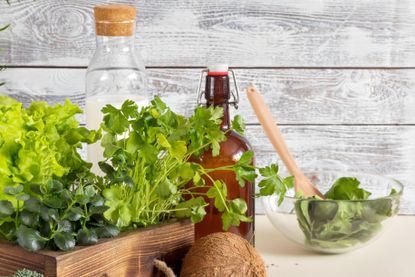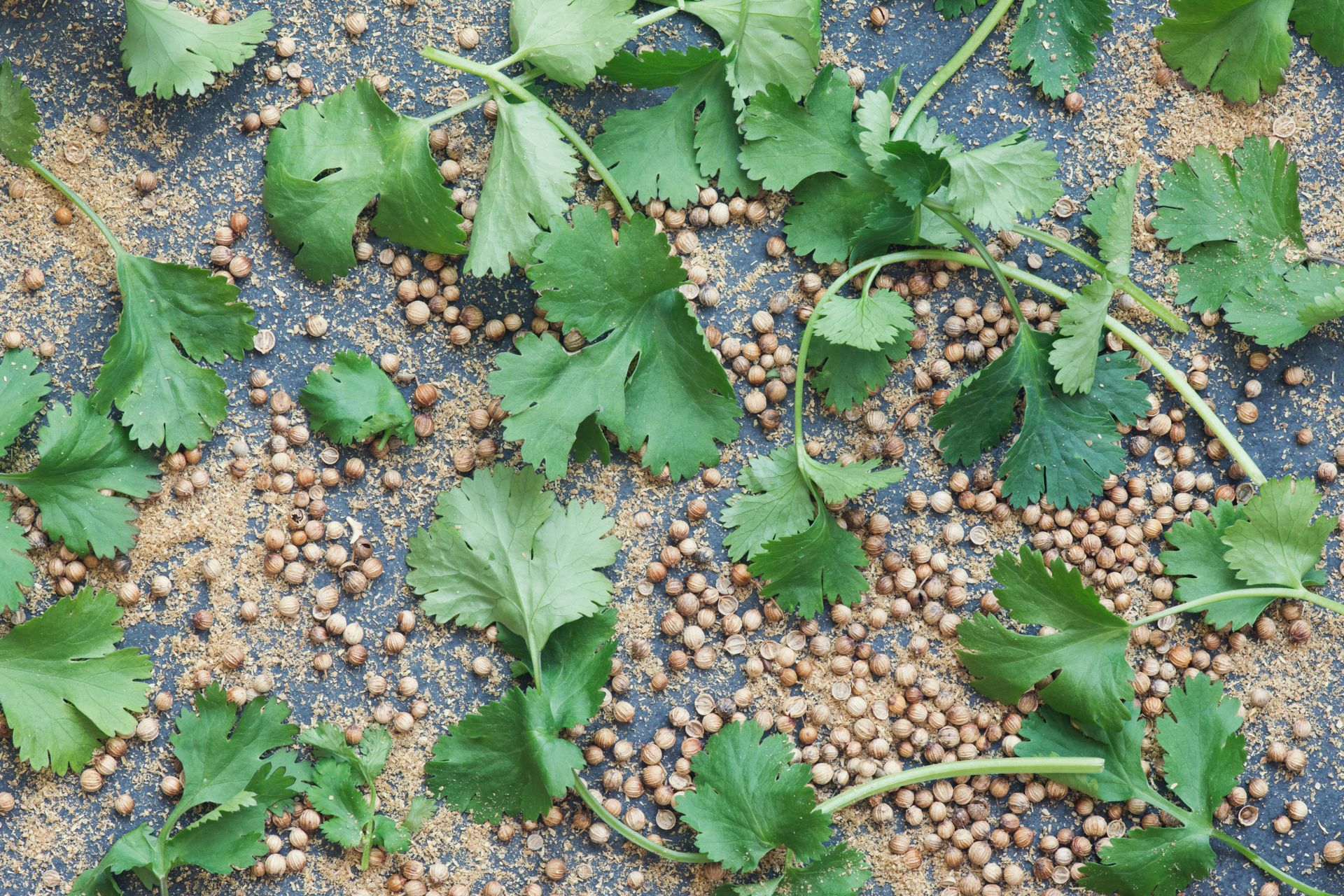How to grow cilantro - the expert guide for this herb garden essential
If you know how to grow cilantro then you can elevate your recipes all summer long


Learning how to grow cilantro was the first herb I ever mastered. I was putting together an herb garden on my city balcony, that ultimately led to me writing two books on growing and eating herbs and edible flowers. And it started with a few cilantro seeds, one pot, and a window.
Cilantro is one of the easiest herbs to grow. Its seeds sprout quickly and it is as happy by a sunny window as it is in a pot outside. But there are a few tricks to making sure the plant grows well, keeps giving you fresh sprigs, and doesn't bolt and become too leggy.
These are the things I learned that quickly became invaluable, keeping me in fresh cilantro all summer long. Conveniently, you can grow it alongside your vegetable garden, or happily indoors.
The trick to growing cilantro is not to over-water, and to cut back regularly. It's an almost foolproof herb, as long you follow these simple guidelines. And cutting it back just means more opportunity to use it in your food and drinks, which is no hardship at all. Trust me, once you've tried a cilantro martini, there is truly no going back.
How to grow cilantro
1. Start with the seeds

Cilantro is one of the easiest herbs to grow from seed. I'd always recommend buying a rosemary plant and nurturing that into a fully grown bush, but you can start cilantro from scratch.
The seeds look just like the ones you'd use to cook with - small, round, brown pellets. They sprout easily, so you don't need to worry too much about how good your soil is.
You can plant cilantro seeds any time from Spring until the early Fall. It takes about six to eight weeks for them to grow into plants you can cook with and eat.
2. Plant cilantro seeds in soil or potting compost
Fill a plant pot or seed tray with potting compost or soil, and make a shallow groove with a chopstick or your finger along the top of it. Sprinkle the seeds into the groove, aiming for a space of around half an inch between each one. Cover with a thin layer of soil.
Press down on the top, to ensure the seeds are coming into really good contact with the soil. Water well, and set aside in a sunny spot - a window ledge that gets sun for most of the day is ideal.
Shoots should start to appear in about one week.
3. Thin out your cilantro shoots

Once your cilantro shoots are around three inches tall, it's time to thin them out. This is straightforward, but a task to be done delicately.
Using something like the handle end of a flatspoon, carefully prize the cilantro shoot out of the soil, being mindful not to damage to roots. Don't pull it, but gently work it out of the soil.
Plant each shoot in its own pot, or 8 inches away from the nearest shoot if putting a few into a larger container. Make a little dip into the surface of the soil, tuck the roots in and cover over. Water well. Leave in the sunshine.
At this point, if it's summer you can move the pot outside. If it's still Spring, and frost is a possibility, keep it indoors.
4. Water and protect your cilantro
You will need to water cilantro whenever the soil is dry - in the hot days of Summer this could daily. It is best to water cilantro in the evening, when the heat has passed, as the plant then drinks and restores itself throughout the night.
Cilantro likes sunshine but does have a tendency to burn if left out in the sun all day. A spot which is sometimes shady, so near a larger plant which shelters it at times, is ideal.
4. Pick cilantro sprigs to use in cooking

Cilantro is ready to pick when the stalks are around 8 inches long. The plant should begin to resemble a cloud of fresh, fragrant greenery, and the leaves should be delicate and pretty.
With a pair of kitchen scissors, cut the stem just above the lowest pair of leaves, to give it the strongest chance of growing back.
You can eat the stalks and the leaves, both cooked and in raw in salads or as a garnish.
5. Start again
Although cilantro does re-grow, over the summer months the stalks will tire and become soft, and the leaves begin to turn yellow. If you want a plentiful supply, it's best to plant new cilantro seeds every month, to keep your harvest coming.
6. Harvest the seeds

Once you know how to grow cilantro you are set for life. The plants will produce seeds, which you can harvest and store for use next year.
As the plants get old, towards the end of the summer, you will notice little green balls appearing, usually in groups of about five or six near the end of a sprig. Pick them and hang them upside down indoors somewhere safe and out of reach. I usually used a bulldog clip to keep them together, hanging the handle over a hook. They will take about three weeks to dry out completely, at which point you can store them in an airtight container for use next year.
What are the best uses for cilantro?
Chef, journalist and recipe writer Ravinder Bhogal has won awards for her cookbooks. Her most recent, Jikoni, is based on the food she serves at her restaurant of the same name in London's Maryleobone. The restaurant is so good that Yotam Ottolenghi himself once said it was the one restaurant in the world he really wished was his.
'Cilantro is wonderful in salsas and pickles,' Ravinder says. 'Blend two parts cilantro with one part mint, a cooking apple and some lime juice for the most extraordinarily fresh pickle that goes well with fish or inside a cheese sandwich.'
She also suggests using cilantro in place of other more widely used herbs. 'Swap out basil for cilandro with carrot tops and pine nuts or cashews for a rich creamy pesto,' she says.
The internationally-acclaimed chef, she suggests using it as a wonderful baste for meat. 'I love using cilantro blended with butter, garlic and lemon zest and juice to stuff under the skin of a chicken,' Ravinder says. 'It has an outstanding flavor.'
Herbs are often seen as finishing touches, and cilantro is no exception. 'If I make an Asian broth, I always put a huge bowl of picked cilantro leaves at the center of the table so my guests can customise their broth by adding it for freshness,' Ravinder says.
What are the best herbs to plant cilantro with?
If you're hoping to create an herb garden, cilantro should be a key plant in your collection. Because cilantro needs a good amount of water and some shade, the best other herbs to plant it with are mint, oregano and chives.
You could also plant it alongside tomatoes, or summer salad leaves such as arugula or mustard.

Can you eat cilantro flowers?
If you have a healthy cilantro plant, it will start producing white flowers after it's two or three months old. The bees and ladybugs love them, so they're a great addition if you're thinking about wildlife gardening.
The great news is that yes, you can eat cilantro flowers. They don't have much flavor - they're nowhere near as strong as the leaves, but they do have a faint aniseed taste. They are delicious and beautiful sprinkled over salads, or used a garnish in cocktails.
Be The First To Know
The Livingetc newsletter is your shortcut to the now and the next in home design. Subscribe today to receive a stunning free 200-page book of the best homes from around the world.

The editor of Livingetc, Pip Rich (formerly Pip McCormac) is a lifestyle journalist of almost 20 years experience working for some of the UK's biggest titles. As well as holding staff positions at Sunday Times Style, Red and Grazia he has written for the Guardian, The Telegraph, The Times and ES Magazine. The host of Livingetc's podcast Home Truths, Pip has also published three books - his most recent, A New Leaf, was released in December 2021 and is about the homes of architects who have filled their spaces with houseplants. He has recently moved out of London - and a home that ELLE Decoration called one of the ten best small spaces in the world - to start a new renovation project in Somerset.
-
 What are the Most Comfortable Pillowcases? From Temperature Regulating to the Best for Your Skin
What are the Most Comfortable Pillowcases? From Temperature Regulating to the Best for Your SkinWhen you're looking for comfort in your pillowcases, material matters. These are the best you can buy
By Faaizah Shah Published
-
 5 Simple, but Genius Bathroom Layout Tricks That Will Make Your Space Work so Much Harder
5 Simple, but Genius Bathroom Layout Tricks That Will Make Your Space Work so Much HarderSmall switches to how you lay out your bathroom that help make the most of a small space
By Luke Arthur Wells Published

